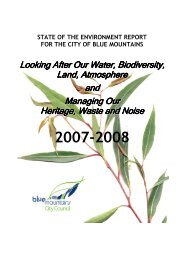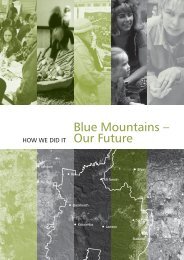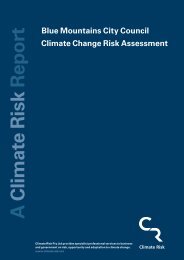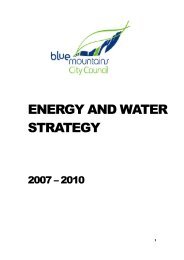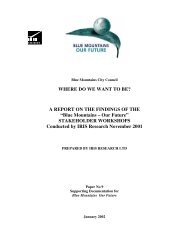State of the Environment Report for the City of Blue Mountains
State of the Environment Report for the City of Blue Mountains
State of the Environment Report for the City of Blue Mountains
You also want an ePaper? Increase the reach of your titles
YUMPU automatically turns print PDFs into web optimized ePapers that Google loves.
Section 1: Biodiversity as a Natural Asset<br />
Our Biodiversity Resources<br />
Effects <strong>of</strong> Stormwater<br />
Stormwater can transport<br />
nutrients from sewage related<br />
effluent and from fertiliser run<strong>of</strong>f<br />
from gardens. Stormwater<br />
<strong>of</strong>ten seeks to collect and<br />
concentrate urban waters,<br />
generating large volumes<br />
with a high velocity, which is<br />
efficient at eroding exposed<br />
soil that is carried into streams.<br />
Elevated nutrients in water<br />
and soil generally favour <strong>the</strong><br />
growth <strong>of</strong> introduced plants<br />
(weeds) over native plants<br />
in bushland environments.<br />
This can encourage weed<br />
infestations and make it harder<br />
<strong>for</strong> local species to compete<br />
and survive. <strong>Blue</strong> <strong>Mountains</strong><br />
streams are rich in aquatic<br />
macro-invertebrates and poor<br />
water quality and sediment<br />
derived from stormwater can<br />
decrease stream biodiversity<br />
and bury habitats.<br />
Fire regimes<br />
Most ecological communities<br />
that occur in <strong>the</strong> <strong>Blue</strong><br />
<strong>Mountains</strong> region are adapted<br />
to <strong>the</strong> periodic occurrence<br />
<strong>of</strong> fire. Many species require<br />
fire to stimulate and facilitate<br />
life cycle processes. Each<br />
community will have optimal<br />
fire regime thresholds that<br />
are influenced by <strong>the</strong> species<br />
and that occur within it. The<br />
sustainability <strong>of</strong> both <strong>the</strong><br />
community and individual<br />
populations can be dramatically<br />
influenced by <strong>the</strong> intervals<br />
at which fire occurs in those<br />
environments. As such, high<br />
frequency fire is listed as a Key<br />
Threatening Process under<br />
<strong>the</strong> NSW Threatened Species<br />
Conservation Act (1995).<br />
During <strong>the</strong> reporting period,<br />
<strong>the</strong>re were 33 incidences <strong>of</strong> fire<br />
involving vegetation attended<br />
by <strong>the</strong> NSW Rural Fire Service<br />
within <strong>the</strong> <strong>City</strong>. Un<strong>for</strong>tunately,<br />
estimates <strong>of</strong> <strong>the</strong> total area <strong>of</strong><br />
burnt land is not available.<br />
However, it is known that<br />
none <strong>of</strong> <strong>the</strong>se fires were <strong>of</strong><br />
significance. It is also unknown<br />
where <strong>the</strong>se fires occurred and<br />
whe<strong>the</strong>r any <strong>of</strong> <strong>the</strong>m occurred<br />
in areas where recurrent fire<br />
at short intervals is placing<br />
pressure on biodiversity.<br />
What is <strong>the</strong> current<br />
state <strong>of</strong> biodiversity<br />
in our region<br />
Threatened ecological<br />
communities<br />
6 communities present within<br />
<strong>the</strong> local government area<br />
have been listed under <strong>the</strong><br />
NSW Threatened Species<br />
Conservation Act (1995)<br />
as Threatened Ecological<br />
Communities, <strong>the</strong>y are: <strong>Blue</strong><br />
<strong>Mountains</strong> Shale Cap Forest,<br />
Shale Sandstone Transitional<br />
Forest, Sydney Turpentine<br />
Iron-bark Forest, Sun Valley<br />
Cabbage Gum Forest, Riverflat<br />
Eucalypt Forest, Newnes<br />
Shrub Swamp, and Montane<br />
Peatlands and Swamps.<br />
4 <strong>of</strong> <strong>the</strong>se communities are<br />
listed as Nationally Threatened<br />
under <strong>the</strong> Commonwealth<br />
<strong>Environment</strong> Protection and<br />
Biodiversity Conservation Act<br />
(1999). This represents an<br />
additional 4 listed communities<br />
in <strong>the</strong> <strong>Blue</strong> <strong>Mountains</strong> since<br />
publication <strong>of</strong> SoE <strong>Report</strong><br />
1999–2000. Fur<strong>the</strong>r threatened<br />
ecological communities are<br />
likely to be listed in <strong>the</strong> <strong>Blue</strong><br />
<strong>Mountains</strong> as a result <strong>of</strong><br />
increased quality and extent<br />
<strong>of</strong> vegetation mapping.<br />
Threatened animal<br />
and plant species<br />
At least 33 species <strong>of</strong> plants<br />
found in <strong>the</strong> local government<br />
area are listed under <strong>the</strong><br />
NSW Threatened Species<br />
Conservation Act (1995). Since<br />
<strong>the</strong> SoE report 1999–2000,<br />
an additional 4 plants and 1<br />
plant population, which occur<br />
in <strong>the</strong> <strong>Blue</strong> <strong>Mountains</strong> have<br />
been listed as threatened<br />
under <strong>the</strong> Act.<br />
There are 36 threatened<br />
animal species known in<br />
<strong>the</strong> local government area,<br />
which are listed under <strong>the</strong><br />
NSW Threatened Species<br />
Conservation Act (1995) and<br />
Fisheries Management Act<br />
(1994). Since <strong>the</strong> 1999–2000<br />
SoE report a fur<strong>the</strong>r 8 animals,<br />
which occur in <strong>the</strong> <strong>Blue</strong><br />
<strong>Mountains</strong> have been listed as<br />
threatened under <strong>the</strong>se Acts.<br />
40 species <strong>of</strong> plant and<br />
animal are listed under <strong>the</strong><br />
Commonwealth <strong>Environment</strong><br />
Protection and Biodiversity<br />
Conservation Act (1999). This<br />
identifies <strong>the</strong> <strong>Blue</strong> <strong>Mountains</strong><br />
as a biodiversity hotspot with<br />
high speciation and locally<br />
restricted populations.<br />
It is unclear whe<strong>the</strong>r increasing<br />
number <strong>of</strong> ecosystems<br />
and species being listed as<br />
threatened in recent years<br />
represents recent changes<br />
in <strong>the</strong>ir threatened status, or<br />
whe<strong>the</strong>r instead it represents<br />
an increase in our awareness<br />
<strong>of</strong> <strong>the</strong>ir reduced population<br />
size and vulnerability.<br />
2005–2006 Supplementary <strong>State</strong> <strong>of</strong> <strong>the</strong> <strong>Environment</strong> <strong>Report</strong> <strong>for</strong> <strong>the</strong> <strong>City</strong> <strong>of</strong> <strong>Blue</strong> <strong>Mountains</strong>



